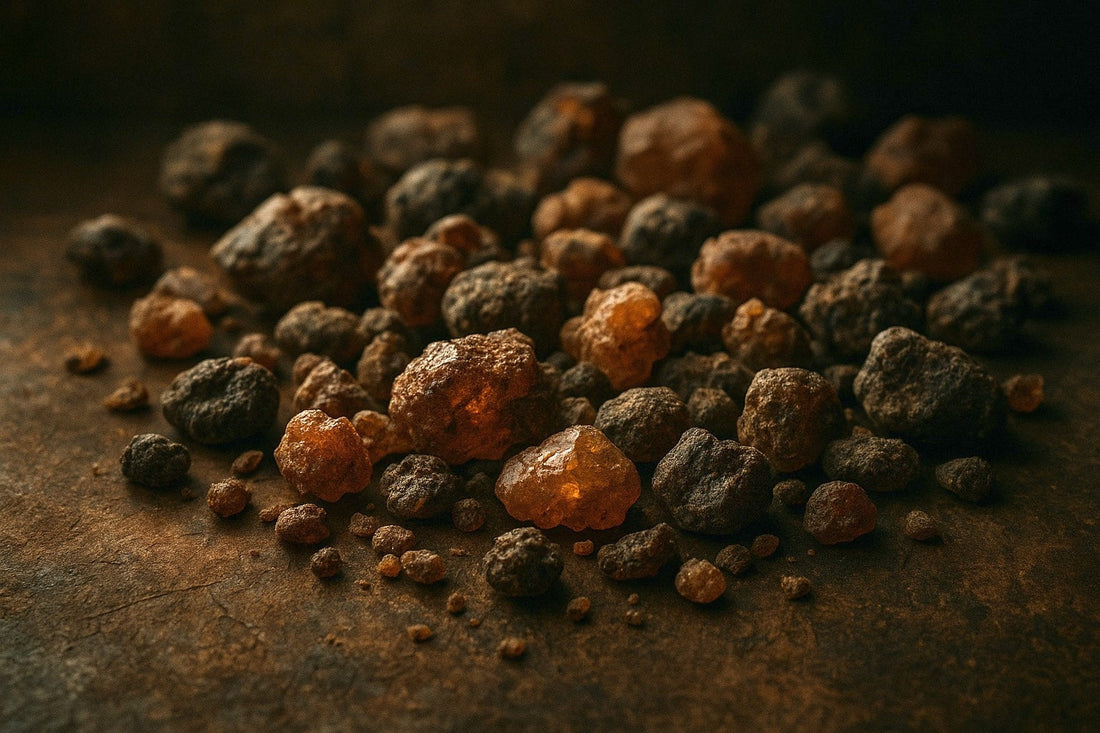
Myrrh Resin: The Scent of Prayer, Protection, and Peace
For thousands of years, myrrh has been burned in temples, blended into incense, and offered in sacred rituals across cultures. Its warm, earthy aroma carries deep spiritual significance and healing associations. Whether used alone or paired with other resins like frankincense, myrrh remains a cornerstone of traditional incense around the world.
In this blog, we explore what makes myrrh such a timeless treasure.
What Is Myrrh?
Myrrh is a natural resin harvested from the Commiphora tree, native to the arid regions of East Africa and the Arabian Peninsula. When the bark is cut, the tree exudes a reddish-brown sap, which hardens into fragrant resin droplets.
These droplets—often called "tears"—are what we burn as incense, crush into powder, or distil into oil. The name “myrrh” comes from the Arabic word murr, meaning "bitter," referencing its sharp, medicinal edge.
A Sacred Scent Across Civilisations
Myrrh has been used since ancient times for:
- Spiritual rituals in Ancient Egypt, Mesopotamia, and Greece
- Embalming and purification in Egyptian funerary rites
- Christian and Biblical ceremonies
- Traditional Chinese Medicine (TCM) for blood circulation
- Ayurveda for wound healing and inflammation
In the Bible, myrrh is one of the three gifts brought by the Magi, symbolising suffering, healing, and spiritual power.
Scent Profile
Myrrh’s fragrance is:
- Warm and earthy
- Resinous, slightly smoky
- With notes of leather, spice, and balsam
It’s often paired with frankincense in incense blends for a balanced and ceremonial aroma. Myrrh is commonly used in evening rituals, prayer, and meditation for its grounding qualities.
Benefits of Burning Myrrh Incense
More than just a ritual fragrance, myrrh offers powerful emotional and spiritual effects:
1. Emotional Healing and Protection
Myrrh is traditionally believed to offer energetic protection, clear negative emotions, and aid emotional recovery from grief or trauma.
Reference: El Ashry, et al. (2003). “Components, therapeutic value and uses of myrrh” Pharmazie.
2. Deepens Meditation and Prayer
Its grounding scent helps centre the mind, slow breathing, and open spiritual awareness—making it a staple for contemplation and sacred ceremonies.
Reference: Lis-Balchin, M. (2006). “Aromatherapy Science: A Guide for Healthcare Professionals.”
3. Supports Respiratory Wellness
When burned in small amounts in ventilated areas, myrrh incense may help clear congestion and promote easier breathing.
How Myrrh Is Used in Incense
You can find myrrh in:
- Pure resin form – burned on charcoal
- Powdered resin – blended with other botanicals
- Sticks and cones – infused with essential oil or myrrh powder
At SomaScents, we feature myrrh in sacred blends like:
- Earth Chant – Grounding and sacred, perfect for deep meditation
- Spice Temple – Warm and spicy, with myrrh anchoring the blend
Ritual Use of Myrrh Incense
Myrrh is traditionally used for:
- Spiritual cleansing of space and aura
- Funerary or ancestral remembrance rituals
- Opening and closing sacred ceremonies
- New moon or introspective journaling rituals
It's associated with the root chakra, helping you feel safe, supported, and connected to the earth.
Final Thoughts
Myrrh connects us to ancient wisdom, spiritual depth, and inner healing. In every curl of smoke, it carries a sense of ritual, grounding, and reverence—making it one of the most enduring incense ingredients in human history.
